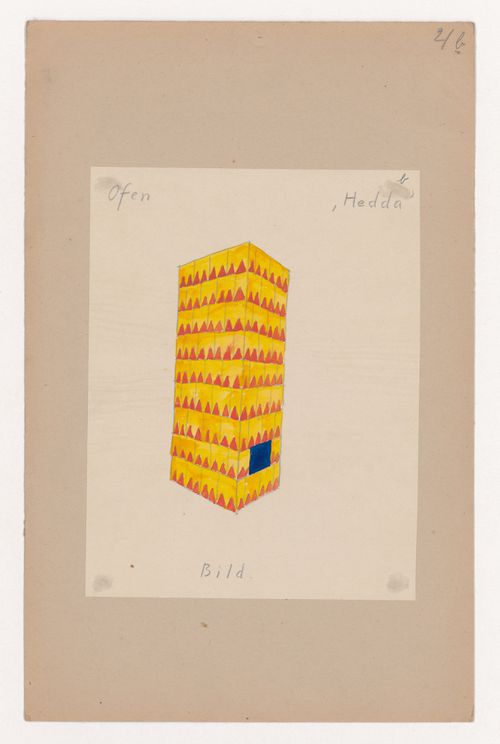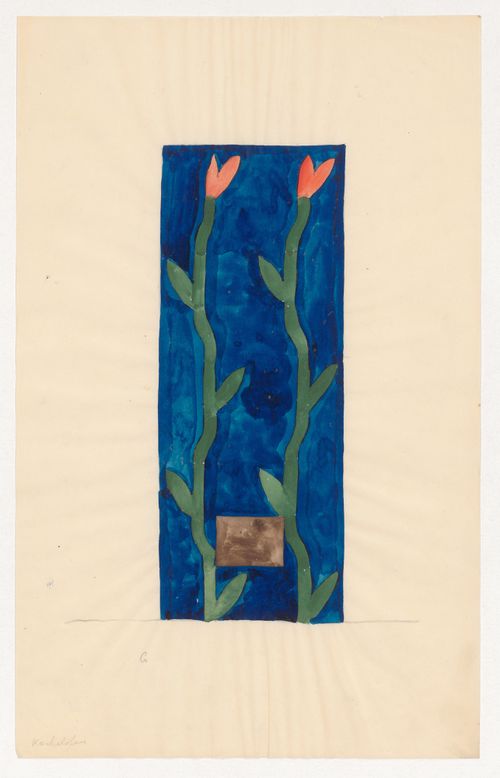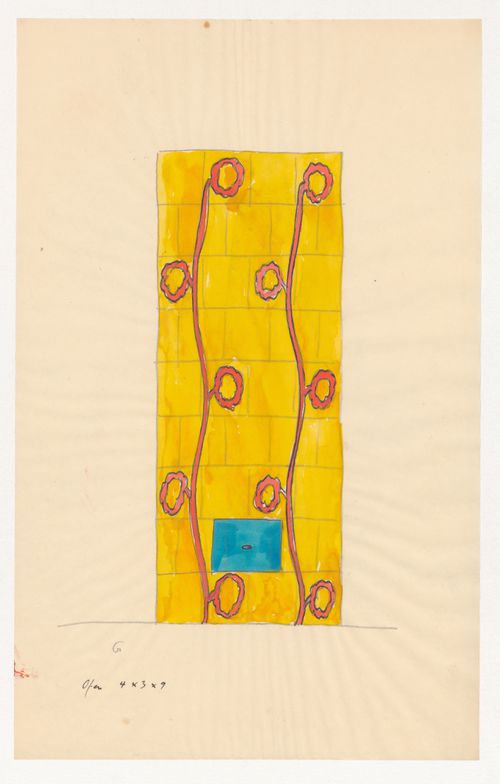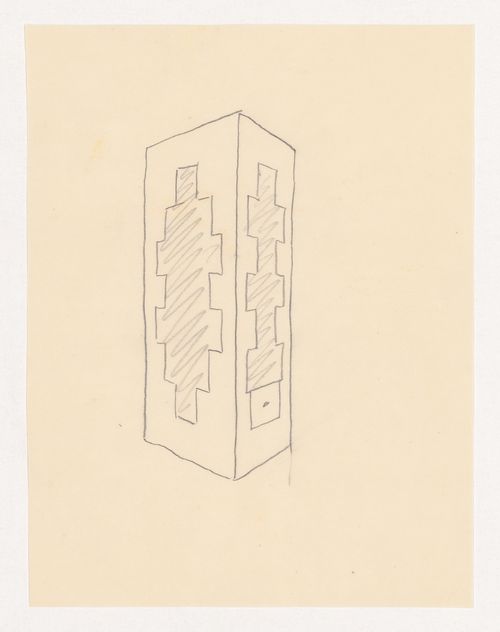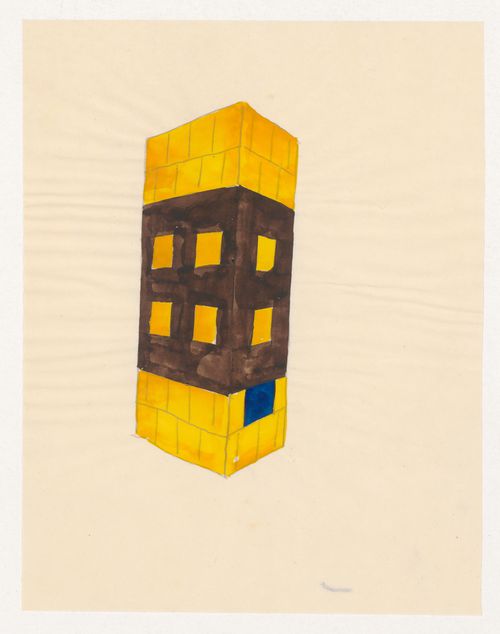books, works of art
Hortorum viridariorumque elegantes & multiplicis formae ad architectonicae artis norman affabre
DR1986:0762:001-035
Description:
- Comprised of a title page and 34 views, the 'Hortorum' of ca. 1600 illustrates a series of designs for town-house gardens. These designs, which together form a kind of pattern book, are characterized by trellis- or gallery-enclosed plots adorned with intricate geometric parterres, topiary, arbours, pavilions and fountains. The parterres shown in plates 1 to 20 represent the artist's personal interpretation of the classical Orders -- Doric, Ionic, and Corinthian -- as applied to garden design.
architecture, landscape architecture
published ca. 1600
Hortorum viridariorumque elegantes & multiplicis formae ad architectonicae artis norman affabre
Actions:
DR1986:0762:001-035
Description:
- Comprised of a title page and 34 views, the 'Hortorum' of ca. 1600 illustrates a series of designs for town-house gardens. These designs, which together form a kind of pattern book, are characterized by trellis- or gallery-enclosed plots adorned with intricate geometric parterres, topiary, arbours, pavilions and fountains. The parterres shown in plates 1 to 20 represent the artist's personal interpretation of the classical Orders -- Doric, Ionic, and Corinthian -- as applied to garden design.
books, works of art
published ca. 1600
architecture, landscape architecture
Project
AP207.S1.2014.PR01
Description:
The project series documents the installation "Architettura "Correta"" designed by Pettena for the exhibition "Soleil Politique" at the Museion in Bolzano, in 2014. The project was a design for a new museum entrance. The installation was made of three glass walls on which were drawn facade details of three historical buildings of the city. The central glass wall represents the entrance from the Piacentini square in Bolzano, with, at its left, a ‘serlian’ arch, and, at its right, a detail of the portico of a ‘Piazza d’Italia’ by Giorgio de Chirico. The idea was to "connect the museum to the city’s history, an architectural element was chosen, one which, in addition to favoring the idea of ‘entrance’ to the exhibit also permitted a view both of the urban and the natural setting, the sky, the mountains, an environment typical of the area in which the city itself rises." [1] The project series contains a sketch and a spiral bound volume with correspondence between Pettena and Pierre Bal Blanc, curator of the exhibitions, and proposals for the installation. The project series also contains photographs of the installation, including printouts. Source: [1] Gianni Pettena website, https://www.giannipettena.it/italiano/opere-1/inst-revised-architecture-2014/ (last accessed 27 January 2020)
2014-2015
Architettura "Correta" ["Revised" Architecture] (2014)
Actions:
AP207.S1.2014.PR01
Description:
The project series documents the installation "Architettura "Correta"" designed by Pettena for the exhibition "Soleil Politique" at the Museion in Bolzano, in 2014. The project was a design for a new museum entrance. The installation was made of three glass walls on which were drawn facade details of three historical buildings of the city. The central glass wall represents the entrance from the Piacentini square in Bolzano, with, at its left, a ‘serlian’ arch, and, at its right, a detail of the portico of a ‘Piazza d’Italia’ by Giorgio de Chirico. The idea was to "connect the museum to the city’s history, an architectural element was chosen, one which, in addition to favoring the idea of ‘entrance’ to the exhibit also permitted a view both of the urban and the natural setting, the sky, the mountains, an environment typical of the area in which the city itself rises." [1] The project series contains a sketch and a spiral bound volume with correspondence between Pettena and Pierre Bal Blanc, curator of the exhibitions, and proposals for the installation. The project series also contains photographs of the installation, including printouts. Source: [1] Gianni Pettena website, https://www.giannipettena.it/italiano/opere-1/inst-revised-architecture-2014/ (last accessed 27 January 2020)
Project
2014-2015
Project
AP075.S1.2003.PR06
Description:
Project series documents Cornelia Hahn Oberlander's landscape design proposal for the Calgary Law Courts, located on the city block between 6th and the 7th Avenue, in Calgary, Alberta. This project was part of a design competition in 2004. Oberlander concept for the landscape consisted in depicting Albert's natural landscape of the Rockies, the foothills, and the prairie. The Rockies were to be recreated with excavation material from the site and would include a water feature spilling in a elongated water basins in the foothills, transforming into the prairie represented by tall grasses. Large lawn and bosque of Aspen trees would represente the City and provides shade and seating areas. The planting plan included the use of low maintenance and indigenous plants. The project also included a green roof on top of the Council Chamber and was planned to allow the reuse of storm water. The project was not realized. The project series contains perspective drawings and site plans showing planters concept, and a complete set of building plans used as reference. The project is also documented throught correspondence, including correspondence with architects, consultants and clients, competition information, competition proposal, including landscape concept proposal by Oberlander, financial documents and photographs of the site.
2003-2004
Calgary Law Courts, Calgary, Alberta (2003-2004)
Actions:
AP075.S1.2003.PR06
Description:
Project series documents Cornelia Hahn Oberlander's landscape design proposal for the Calgary Law Courts, located on the city block between 6th and the 7th Avenue, in Calgary, Alberta. This project was part of a design competition in 2004. Oberlander concept for the landscape consisted in depicting Albert's natural landscape of the Rockies, the foothills, and the prairie. The Rockies were to be recreated with excavation material from the site and would include a water feature spilling in a elongated water basins in the foothills, transforming into the prairie represented by tall grasses. Large lawn and bosque of Aspen trees would represente the City and provides shade and seating areas. The planting plan included the use of low maintenance and indigenous plants. The project also included a green roof on top of the Council Chamber and was planned to allow the reuse of storm water. The project was not realized. The project series contains perspective drawings and site plans showing planters concept, and a complete set of building plans used as reference. The project is also documented throught correspondence, including correspondence with architects, consultants and clients, competition information, competition proposal, including landscape concept proposal by Oberlander, financial documents and photographs of the site.
Project
2003-2004
Series
MarkeTrac and OrderTrac
AP184.S2
Description:
Series 2, MarkeTrac and OrderTrac, 1998-2007, chiefly documents Asymptote’s work bringing 3DTF online through the development and implementation of two web applications. This series includes textual and born-digital components, and chiefly dates from 2000 to 2001. MarkeTrac represents the most significant expansion on 3DTF. Running as a subdomain of the NYSE website for much of the early 2000s, it allowed users to monitor data from a personal computer using the 3DTF interface. Though there were other efforts bringing real-time stock data online at this time, MarkeTrac is significant in that it was the first to include a major data visualization component. Later additions to this project include OrderTrac, a component of MarkeTrac allowing users to buy and sell stocks online. Other unrealized projects related to 3DTF and data visualization were conceptualized during this time. The digital files in this series are chiefly raster images and video of renderings, in addition to a body of handout materials for project presentations. There is also a small body of CAD material in Maya. The textual records are largely handouts for presentation meetings, overlapping significantly with the digital files. There is also a small body of chiefly textual material documenting the conceptualization of other data visualization products.
1991 - 2007
MarkeTrac and OrderTrac
Actions:
AP184.S2
Description:
Series 2, MarkeTrac and OrderTrac, 1998-2007, chiefly documents Asymptote’s work bringing 3DTF online through the development and implementation of two web applications. This series includes textual and born-digital components, and chiefly dates from 2000 to 2001. MarkeTrac represents the most significant expansion on 3DTF. Running as a subdomain of the NYSE website for much of the early 2000s, it allowed users to monitor data from a personal computer using the 3DTF interface. Though there were other efforts bringing real-time stock data online at this time, MarkeTrac is significant in that it was the first to include a major data visualization component. Later additions to this project include OrderTrac, a component of MarkeTrac allowing users to buy and sell stocks online. Other unrealized projects related to 3DTF and data visualization were conceptualized during this time. The digital files in this series are chiefly raster images and video of renderings, in addition to a body of handout materials for project presentations. There is also a small body of CAD material in Maya. The textual records are largely handouts for presentation meetings, overlapping significantly with the digital files. There is also a small body of chiefly textual material documenting the conceptualization of other data visualization products.
Series
1991 - 2007
Project
Museum of Anthropology, University of British Columbia, Vancouver, British Columbia (1975-1977)
AP075.S1.1975.PR01
Description:
Project series documents Cornelia Hahn Oberlander's project for the grounds of the Museum of Anthropology located on the northern end of the University of British Columbia campus. Oberlander worked on this project from 1975-1976 with architect Arthur Erickson. The project was completed in 1976. Due to the location of museum on the Northwest Coast First Nations site, the building was designed to evoke a First Nations longhouse. Oberlander concept for the landscaping was inspired by the Northwest Coast First Nations culture. It initally included a reflecting pool to represent the coastal inlet and an ethnobotanically significant selection of plants. However some features from the original design, such as the reflecting pool and some of the indegenious planting, weren't realized until the mid-2000s. The shield the site from the noise of the busy NW Marine Drive, located next to the grounds, Oberlander included "a series of large mounds planted with Haida seed mix". [1] The project series contains reprographic copies of working drawings, including landscape plans, landscape sections and details, grading and irrigation plans, planting plans, and site plans. The project is also documented through textual records, including specification, correspondence with architects and clients, inspection reports, and some handwritten notes by Oberlander. The project series also comprises photographs of the museum site.
1974-1976
Museum of Anthropology, University of British Columbia, Vancouver, British Columbia (1975-1977)
Actions:
AP075.S1.1975.PR01
Description:
Project series documents Cornelia Hahn Oberlander's project for the grounds of the Museum of Anthropology located on the northern end of the University of British Columbia campus. Oberlander worked on this project from 1975-1976 with architect Arthur Erickson. The project was completed in 1976. Due to the location of museum on the Northwest Coast First Nations site, the building was designed to evoke a First Nations longhouse. Oberlander concept for the landscaping was inspired by the Northwest Coast First Nations culture. It initally included a reflecting pool to represent the coastal inlet and an ethnobotanically significant selection of plants. However some features from the original design, such as the reflecting pool and some of the indegenious planting, weren't realized until the mid-2000s. The shield the site from the noise of the busy NW Marine Drive, located next to the grounds, Oberlander included "a series of large mounds planted with Haida seed mix". [1] The project series contains reprographic copies of working drawings, including landscape plans, landscape sections and details, grading and irrigation plans, planting plans, and site plans. The project is also documented through textual records, including specification, correspondence with architects and clients, inspection reports, and some handwritten notes by Oberlander. The project series also comprises photographs of the museum site.
Project
1974-1976
DR1988:0155
Description:
- Design for a tall, rectangular stove, decorated with yellow and orange tiles. The blue rectangle on the lower right side probably represents the stove door. - The subject of this drawing is identified as a tiled stove by the inscription "Ofen" (stove). This inscription, probably by the draughtsman, occurs on several of the drawings in the group DR1988:0155 - DR1988:0209, as does the inscription "Kachelofen" (tiled stove). Henze illustrates examples of "Kachelofen" which are similar to this one in size and proportion (fig. 105, p.98 and fig. 114, p.103).
interior design
circa 1920-1921
Design for a yellow and orange tiled stove
Actions:
DR1988:0155
Description:
- Design for a tall, rectangular stove, decorated with yellow and orange tiles. The blue rectangle on the lower right side probably represents the stove door. - The subject of this drawing is identified as a tiled stove by the inscription "Ofen" (stove). This inscription, probably by the draughtsman, occurs on several of the drawings in the group DR1988:0155 - DR1988:0209, as does the inscription "Kachelofen" (tiled stove). Henze illustrates examples of "Kachelofen" which are similar to this one in size and proportion (fig. 105, p.98 and fig. 114, p.103).
interior design
DR1988:0182
Description:
- Design for a tall, rectangular tiled stove, decorated with two tulip motifs against a blue background. The brown rectangle near the bottom probably represents the stove door. - The subject of this drawing is identified as a tiled stove by the inscription "Kachelofen" (tiled stove). This inscription, probably by the draughtsman, occurs on several of the drawings in the group DR1988:0155 - DR1988:0209, as does the inscription "Ofen" (stove). Henze illustrates examples of "Kachelofen" which are similar to this one in size and proportion (fig. 105, p. 98 and fig. 114, p.103).
interior design
circa 1920-1921
Design for a tiled stove decorated with tulip motifs
Actions:
DR1988:0182
Description:
- Design for a tall, rectangular tiled stove, decorated with two tulip motifs against a blue background. The brown rectangle near the bottom probably represents the stove door. - The subject of this drawing is identified as a tiled stove by the inscription "Kachelofen" (tiled stove). This inscription, probably by the draughtsman, occurs on several of the drawings in the group DR1988:0155 - DR1988:0209, as does the inscription "Ofen" (stove). Henze illustrates examples of "Kachelofen" which are similar to this one in size and proportion (fig. 105, p. 98 and fig. 114, p.103).
interior design
DR1988:0185
Description:
- Design for a tall, rectangular tiled stove, decorated with orange flower motifs against a yellow background. The blue rectangle near the bottom probably represents the stove door. - The subject of this drawing is identified as a tiled stove by the inscription "Ofen" (stove). This inscription, probably by the draughtsman, occurs on several of the drawings in the group DR1988:0155 - DR1988:0209, as does the inscription "Kachelofen" (tiled stove). Henze illustrates examples of "Kachelofen" which are similar to this one in size and proportion (fig. 105, p.98 and fig. 114, p.103).
interior design
circa 1920-1921
Design for a yellow tiled stove decorated with orange flower motifs
Actions:
DR1988:0185
Description:
- Design for a tall, rectangular tiled stove, decorated with orange flower motifs against a yellow background. The blue rectangle near the bottom probably represents the stove door. - The subject of this drawing is identified as a tiled stove by the inscription "Ofen" (stove). This inscription, probably by the draughtsman, occurs on several of the drawings in the group DR1988:0155 - DR1988:0209, as does the inscription "Kachelofen" (tiled stove). Henze illustrates examples of "Kachelofen" which are similar to this one in size and proportion (fig. 105, p.98 and fig. 114, p.103).
interior design
DR1988:0187
Description:
- Design for a tall, rectangular tiled stove decorated with a geometric pattern. The rectangle near the bottom on the right side probably represents the stove door. - The subject of this drawing is identified as a tiled stove by comparison with similar drawings in the group DR1988:0155 - DR1988:0209. Several of these drawings have identifying inscriptions, such as "Ofen" (stove) and "Kachelofen" (tiled stove), which are probably by the draughtsman. Henze illustrates examples of "Kachelofen" which are similar to this one in size and proportion (fig. 105, p. 98 and fig. 114, p. 103).
interior design
circa 1920-1921
Perspective sketch for a tiled stove decorated with a geometric pattern
Actions:
DR1988:0187
Description:
- Design for a tall, rectangular tiled stove decorated with a geometric pattern. The rectangle near the bottom on the right side probably represents the stove door. - The subject of this drawing is identified as a tiled stove by comparison with similar drawings in the group DR1988:0155 - DR1988:0209. Several of these drawings have identifying inscriptions, such as "Ofen" (stove) and "Kachelofen" (tiled stove), which are probably by the draughtsman. Henze illustrates examples of "Kachelofen" which are similar to this one in size and proportion (fig. 105, p. 98 and fig. 114, p. 103).
interior design
DR1988:0188
Description:
- Design for a tall, rectangular tiled stove, decorated with yellow and brown tiles. The blue rectangle near the bottom on the right side probably represents the stove door. - The subject of this drawing is identified as a tiled stove by comparison with similar drawings in the group DR1988:0155 - DR1988:0209. Several of these drawings have identifying inscriptions, such as "Ofen" (stove) and "Kachelofen" (tiled stove), which are probably by the draughtsman. Henze illustrates examples of "Kachelofen" which are similar to this one in size and proportion (fig. 105, p. 98 and fig. 114, p. 103).
interior design
circa 1920-1921
Perspective sketch for a yellow and brown tiled stove
Actions:
DR1988:0188
Description:
- Design for a tall, rectangular tiled stove, decorated with yellow and brown tiles. The blue rectangle near the bottom on the right side probably represents the stove door. - The subject of this drawing is identified as a tiled stove by comparison with similar drawings in the group DR1988:0155 - DR1988:0209. Several of these drawings have identifying inscriptions, such as "Ofen" (stove) and "Kachelofen" (tiled stove), which are probably by the draughtsman. Henze illustrates examples of "Kachelofen" which are similar to this one in size and proportion (fig. 105, p. 98 and fig. 114, p. 103).
interior design
